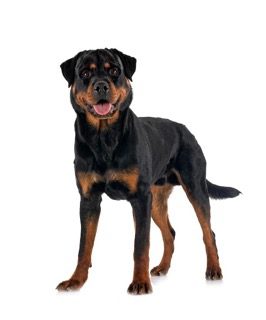
The Rottweiler is a large-sized working breed of domestic dog that originated in Germany. Its history dates back to the Roman Empire, where it was bred as a livestock herding and guard dog. Rottweilers have a muscular, powerful body that usually stands between 24 and 27 inches (61 to 69 cm) tall and weighs around 95 to 135 lbs (43 to 61 kg). Their thick, double coats are black with rust-coloured patches on the legs, muzzle, throat and cheeks. The ears are v-shaped and stand erect, while the eyes are black and almond-shaped. Their noses are black and usually have wide nostrils. The tail is usually docked and their legs are strong and muscular. Common color variations include tan, black and tan, sable, mahogany.
The Rottweiler’s major physical feature is its protective nature, which makes them wonderful family pets and loyal guard dogs. They are intelligent, loving and confident, but also wary of strangers, making them excellent guard dogs. They need early socialization and obedience training to ensure they remain manageable and well-behaved.
What sets the Rottweiler apart from other breeds is its strength, loyalty and intelligence and its ability to work as a herding, guard and search and rescue dog. Rottweilers are known for their intelligence, loyalty, and protective nature. Even though they can be intimidating due to their large size, Rottweilers are very friendly, gentle, and loving towards their families.
They get along well with children and other household pets when properly trained and socialized, and they are patient and tolerant. Early training and socialization are important components of owning a Rottweiler, as they should be taught how to act and behave around other people and pets. Rottweilers are easily trainable, which makes them great companions for those who are willing to put enough time and effort into training them.
Contrary to popular belief, it is possible to keep Rottweilers inside the home. But it’s essential to provide them with plenty of physical and mental stimulation. Because of their size, Rottweilers are relatively quiet dogs, and they don’t bark excessively. Though they may be wary of strangers, they form strong bonds with their owners and can be affectionate and loyal companions.
The Rottweiler is a strong, loyal and powerful breed of dog that requires a diet that supports their large size and muscle mass. Responsible and informed dog ownership is key to ensuring the health and well-being of your Rottweiler, and the nutritional requirements of this breed should be taken into consideration when choosing a suitable diet. A balanced and species-appropriate diet containing adequate amounts of proteins, fats, carbohydrates and essential vitamins and minerals is essential for optimal growth and development and for keeping your Rottweiler in good health.
It is important to feed a high-quality commercial diet specifically formulated for large-breed dogs, and daily exercise and health monitoring should also be part of the routine. For further advice on nutrition and feeding guidelines for your Rottweiler, be sure to check out Way Canina for more information. Keeping your Rottweiler healthy and happy requires informed and responsible ownership, and with the right diet, exercise and veterinary care, your Rottweiler can live a long and fulfilled life.
Health issues common to Rottweilers include hip and joint problems such as dysplasia. They may also be prone to genetic conditions such as hypothyroidism. Regular veterinary check-ups can help detect early signs of health issues in Rottweilers.
Rottweilers typically have a lifespan that ranges from 10 to 12 years, with some living longer. Factors like genetics, diet, exercise, and access to healthcare can all influence a Rottweiler’s longevity. Vaccinations and preventive care can lower the risks of many illnesses. Rottweilers need regular brushing and bathing to keep their fur clean and healthy. Ear cleaning is recommended to prevent ear infections.
Are you considering getting a Rottweiler? Owning a dog is a big responsibility and there’s a lot to consider, such as the pros and cons of owning this breed of dog. Check out our blog posts and articles on Way Canina to compare different breeds and find additional information about dogs’ lifestyle and wellbeing.